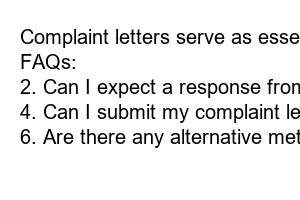지하철 민원문자
Title: Subway Complaint Letter: Advocating for Better Commute Experiences
Introduction:
Subway systems serve as lifelines for millions of people, ensuring a quick and efficient mode of transportation in bustling cities. However, at times, issues arise that leave commuters frustrated and dissatisfied with their experiences. In this blog post, we will discuss the importance of addressing these concerns through complaint letters and how they serve as a catalyst for change.
1. The Power of a Well-Written Complaint Letter:
A well-written complaint letter can be a powerful tool in holding subway authorities accountable for their shortcomings. By clearly articulating the problems faced during a commute, we can contribute to the improvement of services and facilities.
2. Addressing Specific Issues:
Delve deeper into the various common issues faced by subway passengers, such as overcrowding, dirty stations, delays, malfunctioning equipment, and lack of accessibility. Illustrate instances where these issues have hindered daily commutes, emphasizing the need for immediate action.
3. Composing an Effective Complaint Letter:
Highlight the key elements to be included in a complaint letter, such as a concise and direct opening, a detailed description of the incident, and a firm but polite request for action. Encourage readers to be specific, using clear language and supporting evidence when appropriate, to strengthen their case and ensure their concerns are taken seriously.
4. The Importance of Positive Language:
Emphasize the significance of using positive language throughout the complaint letter. Constructive criticism delivered in a friendly tone is more likely to yield favorable results. Encourage readers to avoid accusations and instead focus on the impact of the issue and the potential for improvement.
5. Following Up on the Complaint:
Discuss the importance of following up on the complaint and providing contact information for readers to stay informed. Encourage them to keep records of their interaction with subway authorities, providing a foundation for future complaints if necessary.
6. The Role of Social Media in Amplifying Complaints:
Explore the impact of social media in raising awareness about subway issues. Discuss how sharing experiences and concerns on platforms like Twitter and Facebook can garner attention from both the public and subway authorities, often resulting in a quicker resolution.
7. Summary:
Complaint letters serve as essential tools for improving the overall subway experience. By addressing specific issues, composing effective letters, using positive language, and following up on complaints, commuters can be agents of change. Additionally, leveraging social media platforms can increase the visibility and impact of these concerns. Together, we can ensure that subway systems provide safe, efficient, and pleasant commutes for all.
FAQs:
1. Should I include personal details in my complaint letter?
2. Can I expect a response from subway authorities?
3. Is there a timeframe within which I should expect action to be taken?
4. Can I submit my complaint letter through email?
5. How can I involve local representatives in addressing subway issues?
6. Are there any alternative methods to report subway complaints if my letter goes unanswered?

